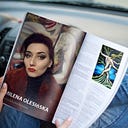Emilio Vedova — Abstract Artworks
Revolutionary Italian artist whose abstract expressionism fused politics with wild, sensuous painting
“The Italian painter Emilio Vedova, who has died aged 87, was a veteran of one of the 20th century’s most bitter artistic conflicts — the “battle of styles” in the 1950s between the neo-realists and the pioneers of expressive abstraction. Like many fierce quarrels, this dispute was conducted between former friends, in this case the leftwing intellectuals who had taken part in the Italian resistance during the second world war. Some of them believed that socialist painters should follow the example of Picasso’s Guernica and create overtly political, figurative images, preferably on a grand scale; others, including Vedova, argued that revolutionary art had, by its very nature, to be abstract.This conviction led him, in the 1950s, to fill his pictures with wild patterns of smeared, poured and dripped paint. He became a radical in both politics and technique, truly a Jackson Pollock of the barricades.The third of seven children, Vedova was born into a Venetian artisan family: his father was a house painter and decorator. By the age of 11, Emilio was forced to earn his living, initially in a factory and then in the studios of a photographer and restorer. Although he briefly took evening art classes at the Scuola dei Carmini in Venice, he was mainly self-taught, cutting his teeth with sketches of local buildings and Renaissance paintings.In 1937 Vedova made two pictures, The Raising of Lazarus and Crucifixion from Behind, whose bold light effects and unusual viewpoints were undoubtedly inspired by the 16th-century artist Tintoretto. But his most extraordinary work that year, a representation of his own naked body reflected in a mirror on the floor, also showed more contemporary influences, especially from Maurice de Vlaminck and Georges Rouault. Densely painted on coarse, unprimed canvas, it is one of the rawest, most visceral self-portraits of the 20th century.During the second world war, Vedova lived mostly away from Venice. He was involved in 1943 with Corrente, a Milanese group whose manifesto proclaimed “the revolutionary function of painting … With our painting we are going to hoist flags.” Soon afterwards he joined the resistance in Rome, recording his experiences in the partisan drawings that were later exhibited across Italy.At the end of the war Vedova returned to Venice, where his work became progressively more abstract, combining sombre tones with flat, angular planes partly influenced by cubism and futurism. These black geometries eloquently express the anxiety and anguish of the period. The World on its Tiptoes (1946) and The Struggle (1949) were followed in 1950 by Concentration Camp, a pattern of spiky shapes with a pool of red at its core.Such imagery clearly followed the principles of the manifesto Beyond Guernica, co-signed by Vedova in 1946, which urged artists to engage with reality without being naturalistic. For a short while the division between figurative and abstract painters was concealed by the Fronte Nuovo delle Arti, which Vedova helped to found in 1947. However, by 1952 he had joined the more avant-garde Gruppo degli Otto, led by the critic Lionello Venturi. The uneasy alliance had collapsed.By this time Vedova had also developed contacts abroad, especially in New York, where he exhibited for the first time in 1951. His style was now close to the free abstraction of French art informel and American action painting, but, unlike many of his foreign contemporaries, Vedova saw the spirit of revolution in even the most sensuous, luscious brushstrokes. And if the spectators did not share his vision, they could at least read the titles — Protest Cycle, Universal Manifesto, Korea.References to contemporary events became even more urgent when Vedova was made an official artist-in-residence in Berlin just two years after the construction of the wall in 1961. Working in a studio formerly occupied by the Nazi sculptor Arno Breker, he created the Absurd Berlin Diary 64, a colossal assemblage of jagged wooden pieces, aggressively painted in clashing colours, which conveyed the trauma of the divided city. Hung from the ceiling or arranged untidily across the gallery floor, often linked by hinges like parodies of medieval polyptychs, the panels also illustrated the artist’s desire to liberate art from its conventional setting in a frame on a wall…………”( theguardian.com )
